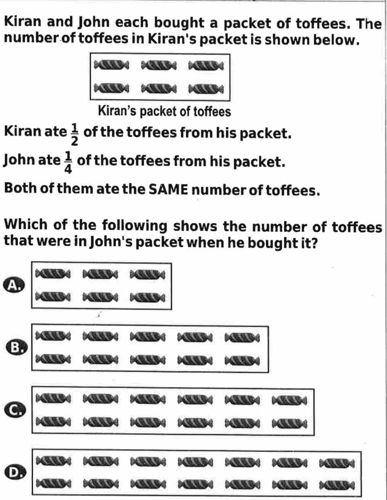Kiran and John each bought a packet of toffees. The number of toffees in Kiran's packet is shown below. Kiran ate 1/2 of the toffees from his packet. John ate 1/4 of the toffees from his packet. Both of them ate the SAME number of toffees. Which of the following shows the number of toffees that were in John's packet when he bought it?

Answer
To solve this problem, we first determine how many toffees Kiran initially had. Kiran ate 1/2 of his toffees. Let's denote the total number of toffees in Kiran's packet as K. Therefore, he ate K/2 toffees. Now, let the initial number of toffees in John's packet be J. John ate 1/4 of the toffees from his packet, which means he ate J/4 toffees. According to the problem, Kiran and John ate the same number of toffees. Thus, we can set up the equation: K/2 = J/4. To eliminate the fractions, we multiply both sides by 4: 4*(K/2) = 4*(J/4) This simplifies to: 2K = J. This means that the number of toffees in John's packet when he bought it (J) is double the number of toffees Kiran had (K). Now we look at the problem where Kiran's packet is displayed: - Kiran has 12 toffees in total (as represented by 12 pieces in the image). To find J, we substitute K with 12: J = 2 * 12 = 24. Thus, John had 24 toffees in his packet when he bought it. Now, from the options provided: - We need to find an option that shows John had 24 toffees initially, which would be represented by 24 pieces of toffees. Therefore, the correct option corresponds to John's packet having 24 toffees when he bought it.